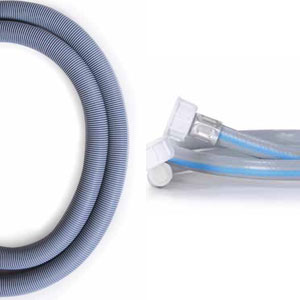Understanding Pipe Selection and Replacement
In the world of plumbing and piping systems, it is not uncommon for homeowners and contractors to be confused about the differences between flexible and straight pipes. Many times, the assumption is made that flexible pipes can simply be replaced with straight pipes.
However, this is not always the case, and understanding the specific uses and advantages of flexible pipes is crucial for making informed decisions when it comes to pipe selection and replacement.
The Differences between Flexible and Straight Pipes
Flexible pipes, also known as corrugated pipes, are made from a variety of materials including plastic and metal. The defining characteristic of a flexible pipe is its ability to bend and conform to any shape, making it ideal for use in tight spaces and around obstacles. On the other hand, straight pipes are rigid and have a fixed shape, making them less versatile in terms of installation and placement.
Specific Applications and Uses of Flexible Pipes
Flexible pipes are commonly used in a variety of applications, including drainage systems, sewage systems, and even natural gas pipelines. Due to their ability to bend and conform to any shape, flexible pipes are often used in areas where straight pipes cannot be used. For example, flexible pipes can be used to navigate around corners, or to traverse rough and uneven terrain.
Advantages and Disadvantages of Using Flexible Pipes
One of the biggest advantages of using flexible pipes is their versatility and ease of installation. They can be easily cut to length and bent to fit into tight spaces and around obstacles, making them ideal for use in a variety of applications. Additionally, flexible pipes are often more resistant to damage from impact and vibrations, making them a durable option for long-term use.
However, there are some disadvantages to using flexible pipes as well. For example, they are typically more expensive than straight pipes, and they are more prone to leaks due to their flexible nature.
Why Replacing a Flexible Pipe with a Straight Pipe is Not Recommended
Despite the potential cost savings, replacing a flexible pipe with a straight pipe is not always the best solution. In fact, doing so can often lead to more problems and costly repairs in the long run. This is because straight pipes are rigid and have a fixed shape, making them less adaptable to the specific needs of each application. Additionally, straight pipes are more prone to breaking and cracking, which can cause leaks and other issues.
Tips for Selecting the Right Type of Pipe for a Specific Application
In conclusion, understanding the specific advantages and disadvantages of both flexible and straight pipes is crucial for making informed decisions when it comes to pipe selection and replacement. While it may be tempting to replace a flexible pipe with a straight pipe for cost reasons, it is important to consider the specific needs and requirements of each application. When in doubt, it is always best to consult with a professional plumber or contractor for guidance on selecting the right type of pipe for your specific needs.
To learn more about Terraflex solutions for all your piping needs, contact our team today!
Frequently Asked Questions about Flex Pipe
Q: Are there any safety concerns associated with replacing flex pipe with straight pipe?
A: Yes, replacing flex pipe with straight pipe can pose safety concerns. Flex pipe is often utilized in applications where movement, vibration, or bending is expected. Using straight pipe in these situations can compromise the integrity of the system, potentially leading to leaks, pipe bursts, or damage to the surrounding infrastructure.
Q: Does using flex pipe offer any noise reduction benefits compared to straight pipe?
A: Yes, flex pipe can provide noise reduction benefits compared to straight pipe. Its flexibility helps absorb vibrations and reduces the transmission of noise caused by flowing fluids or system movements. This can be particularly beneficial in HVAC systems or plumbing applications where noise reduction is desired.
Q: Can the use of straight pipe instead of flex pipe affect the lifespan of the system?
A: Yes, using straight pipe instead of flex pipe can potentially affect the lifespan of the system. The lack of flexibility in straight pipe can subject the system to increased stress, leading to premature wear, fatigue, or failure. Flex pipe’s ability to accommodate movements and vibrations helps prolong the lifespan of the system by reducing stress on the components.

